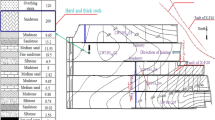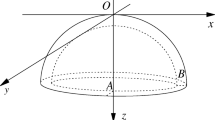Abstract
High-intensity longwall top coal caving (LTCC) mining of super-thick coal seam in high stress conditions often leads to significant movement and failure of overburden. The competent roof above the super-thick coal seam is easy to form large unstable structures, and the breaking and movement of the roof strata often induce high weighting strength and large dynamic disasters which severely affect the mine safety. The key to control the behavior of competent roof is to understand the fracturing law of the roof strata. In this paper, a case study based on microseismic (MS) monitoring was performed at LW8309 working face in Tongxin coal mine, where super-thick coal seam under competent sandstone roof in high stress conditions was mined by LTCC method. The spatial distribution characteristics of MS events were studied and four impact zones in the horizontal direction and ‘four-zones’ in the vertical direction were identified. Multifractal analysis of MS events was carried out to study the multifractal characteristics of the fracturing of competent overburden. In addition, a large and small periodic law of fracturing of competent roof was revealed from the temporal distribution of MS events and on-site monitoring of hydraulic support pressure. A key stratum (KS) structural model was then proposed to explain the strong behaviors of competent strata during high-intensity mining. The research results are of great significance for safe and efficient mining of super-thick coal seam under competent roof in high stress conditions.
Highlights
-
The impact zones in front of the mining face and four vertical zones were identified and the fracture characteristics of the competent overburden in the impact zones and the vertical zones were revealed.
-
Multifractal characteristics of the fracture of the competent overburden were obtained.
-
A large and small periodic law of fracture of competent overburden was revealed from the temporal distribution of MS events and on-site monitoring of hydraulic support pressure.
-
A key stratum (KS) structural model was proposed to explain the behavior of the fracture of competent overburden.




















Similar content being viewed by others
Data availability
The data used to support the findings of this study are available from the corresponding author upon request.
References
Bai QS, Tu SH, Wang FT, Cun Z (2017) Field and numerical investigations of gateroad system failure induced by hard roofs in a longwall top coal caving face. Int J Coal Geol 173:176–199
Chen Y, Ma SQ, Yu Y (2017) Stability control of underground roadways subjected to stresses caused by extraction of a 10-m-thick coal seam: a case study. Rock Mech Rock Eng 50(9):1–10
Dai F, Li B, Xu NW, Zhu YG (2017) Microseismic early warning of surrounding rock mass deformation in the underground powerhouse of the Houziyan hydropower station, China. Tunn Undergr Sp Tech 62:64–74
Fan JA, Dou LA, He HA, Du TB (2012) Directional hydraulic fracturing to control hard-roof rockburst in coal mines. Int J Min Sci Technol 22(2):177–181
Feng LF, Dou LM, Wang XD (2018) Mechanism of mining advance speed on energy release from hard roof movement, China. J China Coal Soc 44(11):3329–3339
Gao MZ, Jin WC, Dai ZX, Xie J (2013) Relevance between abutment pressure and fractal dimension of crack network induced by mining. Int J Rock Mech Min 23:925–930
Gao MZ, Zhang JG, Li SW, Wang M (2020) Calculating changes in fractal dimension of surface cracks to quantify how the dynamic loading rate affects rock failure in deep mining. J Cent South Univ 27(10):3013–3024
Guo WJ, Li YY, Yin DW (2016) Mechanisms of rock burst in hard and thick upper strata and rock-burst controlling technology. Arab J Geosci 9(10):561
Guo J, Feng GR, Wang PF, Qi TY (2018) Roof strata behavior and support resistance determination for ultra-thick longwall top coal caving panel: a case study of the Tashan coal mine. Energies 11(5):1041
Hirabayashi T, Ito K, Yoshii T (1992) Multifractal analysis of earthquakes. Pure Appl Geophys 138(4):591–610
Hirata T, Imoto M (2010) Multifractal analysis of spatial distribution of microearthquakes in the Kanto region. Geophys J Int 107(1):155–162
Jiang HJ, Cao SG, Zhang Y (2016) Analytical solutions of hard roof’s bending moment, deflection and energy under the front abutment pressure before periodic weighting. Int J Min Sci Technol 1:175–181
Jiang LS, Zhang PP, Chen LJ (2017) Numerical approach for goaf-side entry layout and yield pillar design in fractured ground conditions. Rock Mech Rock Eng 50(11):3049–3071
Ju JF, Xu JL (2013) Structural characteristics of key strata and strata behaviour of a fully mechanized longwall face with 7.0 m height chocks. Int J Rock Mech Min 58:46–54
Lan YW, Gao RR, Yu B (2018) In situ studies on the characteristics of strata structures and behaviors in mining of a thick coal seam with hard roofs. Energies 11(9):2470
Li SL, Yin XG, Zheng WD, Trifu C (2005) Research of multi-channel microseismic monitoring system and its application to fankou lead-zinc mine. Chin J Rock Mech Eng 24(12):2048–2053
Li T, Cai MF, Cai M (2007) A review of mining-induced seismicity in China. Int J Rock Mech Min 44(8):1149–1171
Li Y, Yang TH, Liu HL, Wang H (2016) Real-time microseismic monitoring and its characteristic analysis in working face with high-intensity mining. J Appl Geophys 132:152–163
Li C, Xie HP, Gao MZ, He ZQ (2020) Case study on the mining-induced stress evolution of an extra-thick coal seam under hard roof conditions. Energy Sci Eng 8:3174–3185
Liu JH, Jiang FX, Zhu ST (2015) Study of dynamic and static abutment pressure around longwall face and its application. Chin J Rock Mech Eng 34(09):1815–1827
Liu C, Xue J, Yu G, Cheng X (2016) Fractal characterization for the mining crack evolution process of overlying strata based on microseismic monitoring technology. Int J Min Sci Technol 26:295–299
Mahdevari S, Shahriar K, Sharifzadeh M (2016) Assessment of failure mechanisms in deep longwall faces based on mining-induced seismicity. Arab J Geosci 9(18):709
Mondal D, Roy P, Behera P (2017) Use of correlation fractal dimension signatures for understanding the overlying strata dynamics in Longwall coal mines. Int J Rock Mech Min 91:210–221
National Coal Ministry Administration of China (2000) Standard of mining coal seams affected by buildings, water bodies, railways and designing coal pillars for main roadways. Coal Industry Press, Beijing, China
Ning JG, Wang J, Jiang LS, Jiang N (2017) Fracture analysis of double-layer hard and thick roof and the controlling effect on strata behavior: a case study. Eng Fail Anal 81:117–134
Palchik V (2003) Formation of fractured zones in overburden due to longwall mining. Environ Geol 44(1):28–38
Palchik V (2005) Localization of mining-induced horizontal fractures along rock layer interfaces in overburden: field measurement and prediction. Eng Geol 48(1):68–80
Pastén D, Comte D (2014) Multifractal analysis of three large earthquakes in Chile: Antofagasta 1995, Valparaiso 1985, and Maule. J Seismo 18(4):707–713
Qian MG, Xue JL (1998) Study on the “O-shape” circle distribution characteristics of mining-induced fractures in the overlaying strata. J China Coal Soc 23(5):466–469
Qian MG, Miao XX, Xu JL (1996) Theoretical study of key stratum in ground control. J China Coal Soc 21(3):225–230
Qian MG, Shi PW, Xu JL (2010) Ground pressure and strata control. China University of Mining and Technology Press, Xuzhou, China
Unver B, Yasitli NE (2006) Modeling of strata movement with a special reference to caving mechanism in thick seam coal mining. Int J Coal Geol 66:227–252
Urbancic T, Trifu C (2000) Recent advances in seismic monitoring technology at Canadian mines. J Appl Geophys 45(4):225–237
Wang JH, Wang ZH (2015) Impact effect of dynamic load induced by roof in high-intensity mining face, China. Chin J Rock Mech Eng 34(S2):3987–3997
Wang J, Jiang JQ, Li GB (2016a) Exploration and numerical analysis of failure characteristic of coal pillar under great mining height longwall influence. Geotech Geol Eng 34(2):689–702
Wang J, Ning JG, Jiang JQ, Bu TT (2016b) Research on the energy criterion for rockbursts induced by broken hard and thick rock strata and its application. Geotech Geol Eng 35(2):1–16
Wang P, Jiang JQ, Zhang PP (2016c) Breaking process and mining stress evolution characteristics of a high-position hard and thick stratum. Int J Min Sci Technol 26(4):563–569
Wang G, Wu M, Wang R (2017) Height of the mining induced fractured zone above a coal face. Eng Geol 216:140–152
Wu QS, Jiang JQ, Wu QL, Xue YC (2018) Study on the fracture of hard and thick sandstone and the distribution characteristics of microseismic activity. Geotech Geol Eng 36:3357–3373
Xie HP, Chen ZH, Wang JC (1999a) Three-dimensional numerical analysis of deformation and failure during top coal caving. Int J Rock Mech Min 36(5):651–658
Xie HP, Yu GM, Yang L, Zhang YZ (1999b) Research on the fractal effects of crack network in overburden rock stratum. Chin J Rock Mech Eng 18(2):147–151
Xie J, Gao MZ, Zhang R, Li SW (2016) Lessons learnt from measurements of vertical pressure at a top coal mining face at Datong Tashan Mines, China. Rock Mech Rock Eng 49:2977–2983
Yu GM, Xie HP, Zhao JF, Lun Y (2000) Fractal evolution of a crack network in overburden rock stratum. Discret Dyn Nat Soc 5(1):47–52
Yu B, Zhao J, Kuang T, Meng X (2015) In situ investigations into overburden failures of a super-thick coal seam for longwall top coal caving. Int J Rock Mech Min 78:155–162
Yu B, Zhao J, Xiao HT (2017) Case study on overburden fracturing during longwall top coal caving using microseismic monitoring. Rock Mech Rock Eng 50(2):507–511
Zhao T, Liu CY, Yetilmezsoy K, Zhang BS (2017) Fractural structure of thick hard roof stratum using long beam theory and numerical modeling. Environ Earth Sci 76(21):751
Zhao TB, Guo WY, Han F (2018) Analysis on energy accumulation and release of roof under influence of mining speed, China. Coal Sci Technol 46(10):37–44
Zhu ZJ, Zhang HW, Nemcik J (2018) Overburden movement characteristics of top-coal caving mining in multi-seam areas. Q J Eng Geol Hydrogeol 51(2):276–286
Zhang A, Xie H, Zhang R, et al (2023) Mechanical properties and energy characteristics of coal at different depths under cyclic triaxial loading and unloading. Int J Rock Mech Min Sci 161(1):105271. https://doi.org/10.1016/j.ijrmms.2022.105271
Acknowledgements
The authors would like to acknowledge the support by the National Natural Science Foundation of China (U2013603; 52004167; 51822403) and Sichuan International Technological innovation Cooperation Project (2018HH0159).
Funding
National natural science foundation of china, U2013603, Mingzhong Gao, 52004167, Mingzhong Gao, 51822403, Mingzhong Gao.
Author information
Authors and Affiliations
Corresponding author
Ethics declarations
Conflict of interest
The authors declare that they have no conflicts of interests.
Additional information
Publisher's Note
Springer Nature remains neutral with regard to jurisdictional claims in published maps and institutional affiliations.
Rights and permissions
Springer Nature or its licensor (e.g. a society or other partner) holds exclusive rights to this article under a publishing agreement with the author(s) or other rightsholder(s); author self-archiving of the accepted manuscript version of this article is solely governed by the terms of such publishing agreement and applicable law.
About this article
Cite this article
Deng, G., Xie, H., Gao, M. et al. Fracture Mechanisms of Competent Overburden Under High Stress Conditions: A Case Study. Rock Mech Rock Eng 56, 1759–1777 (2023). https://doi.org/10.1007/s00603-022-03169-z
Received:
Accepted:
Published:
Issue Date:
DOI: https://doi.org/10.1007/s00603-022-03169-z




